![[Digital logo]](../../IMAGES/DIGITAL-LOGO.GIF)
![[HR]](../../IMAGES/REDBAR.GIF)
![[Digital logo]](../../IMAGES/DIGITAL-LOGO.GIF)
![[HR]](../../IMAGES/REDBAR.GIF)
This appendix describes the structure of an accounting file. It is for programmers who want to access accounting data directly.
Note
The formats described here are subject to change without notice in a future release.
The symbols and offsets described in this appendix are defined by the
$ACRDEF macro in the STARLET library.
C.1 Format of an Accounting File Record
An accounting record consists of an accounting record header and a number of information packets. The number and type of information packets depend on the type of the record.
Figure C-1 illustrates the general format of an accounting record. Table C-2 describes the fields in the record header. The type field in the record header is subdivided into five fields, described in Table C-3.
Figure C-1 Format of an Accounting Record
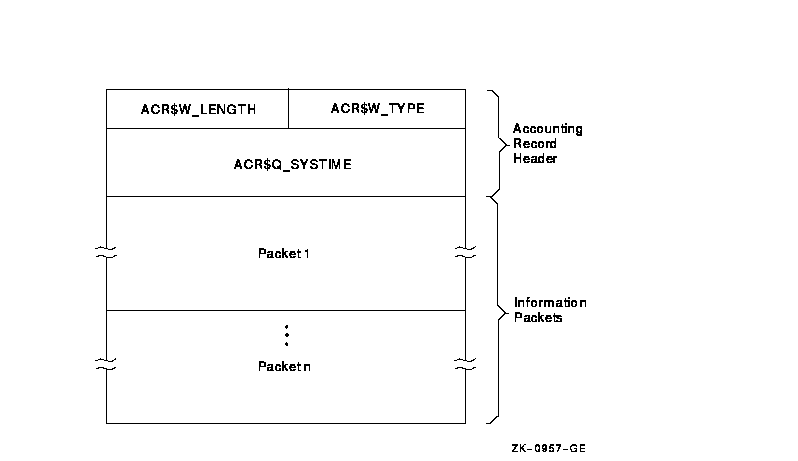
| Symbolic Offset | Description |
|---|---|
| ACR$W_TYPE | Identifies the type of the record. This field is subdivided into five fields, described in Table C-3. (word) |
| ACR$W_LENGTH | Total length of the record, in bytes. (word) |
| ACR$Q_SYSTIME | System time (64-bit absolute time). (quadword) |
| Symbolic Offset | Description | ||||||||||||
|---|---|---|---|---|---|---|---|---|---|---|---|---|---|
| ACR$V_PACKET | Identifies this header as a record header. This bit must be 0. (1 bit) | ||||||||||||
| ACR$V_TYPE | Identifies the type of the record. The eight record types are described in Table C-4. (7 bits) | ||||||||||||
| ACR$V_SUBTYPE |
Identifies the type of process with which the record is associated. The
subtypes (4 bits) are:
Note that this field is only meaningful for records of type ACR$K_IMGDEL and ACR$K_PRCDEL. |
||||||||||||
| ACR$V_VERSION |
Identifies the version of the accounting file record structure. The
versions (3 bits) are:
|
||||||||||||
| ACR$V_CUSTOMER | Identifies whether the record was written by Digital software or by customer software. If this bit is 0, the record was written by Digital software. If this bit is 1, the record was written by customer software. (1 bit) |
Note
ACR$K_CURVER = Current version. Set equal to ACR$K_VERSION3 in this release.
The type of an accounting record identifies the type of event that caused the record to be logged. The eight types of accounting records are shown in Table C-4. This table shows the information packets contained in each type of record.
| Symbol | Event | Information Packets |
|---|---|---|
| ACR$K_FILE_BL | The accounting file was opened | ACR$K_FILENAME |
| ACR$K_FILE_FL | The accounting file was closed | ACR$K_FILENAME |
| ACR$K_IMGDEL | An image terminated |
ACR$K_ID
ACR$K_RESOURCE ACR$K_IMAGENAME |
| ACR$K_LOGFAIL | A login attempt failed |
ACR$K_ID
ACR$K_RESOURCE |
| ACR$K_PRCDEL | A process terminated |
ACR$K_ID
ACR$K_RESOURCE |
| ACR$K_PRINT | A print job finished |
ACR$K_ID
ACR$K_PRINT |
| ACR$K_SYSINIT | The system was initialized |
ACR$K_ID
ACR$K_RESOURCE |
| ACR$K_USER | An accounting message was sent by the $SNDJBC system service |
ACR$K_ID
ACR$K_USER_DATA |
The header, in each of the six types of information packets, defines the type of packet as follows:
Section C.1.2.1 describes the general format of an information packet.
Section C.1.2.2 to Section C.1.2.7 describe the format of each type of
information packet.
C.1.2.1 General Format
Each information packet contains a packet header, followed by data fields. The data fields can contain fixed-length data, variable-length data, or offsets to variable-length data. Offsets contain the distance in bytes from the beginning of the packet to the variable-length data.
All variable-length data are represented as counted strings. Variable-length data follow the last fixed-length data field in the packet. Figure C-2 shows the general format of an information packet. An information packet may not have values in all of its data fields.
See Section C.1.2.2 to Section C.1.2.7 for complete descriptions of the data fields contained in each information packet.
All information packets start with a packet header that has ACR$W_LENGTH and ACR$W_TYPE fields (see Table C-5 and Table C-6).
Figure C-2 Format of an Information Packet

| Symbolic Offset | Description |
|---|---|
| ACR$W_TYPE | Identifies the type of the packet. This field is subdivided into five fields, described in Table C-6. (word) |
| ACR$W_LENGTH | Total length of the packet, in bytes. (word) |
| Symbolic Offset | Description | ||||||||||||||
|---|---|---|---|---|---|---|---|---|---|---|---|---|---|---|---|
| ACR$V_PACKET | Identifies this header as a packet header. This bit must be 1. (1 bit) | ||||||||||||||
| ACR$V_TYPE |
Identifies the type of the packet. The six packet types (7 bits) are:
|
||||||||||||||
| ACR$V_SUBTYPE | Identifies the packet subtype; reserved for future use. (4 bits) | ||||||||||||||
| ACR$V_VERSION | See Table C-3. | ||||||||||||||
| ACR$V_CUSTOMER | See Table C-3. |
The file name packet contains the name of the accounting file. Figure C-3 shows the format of the file name packet. Table C-7 describes the field contained in the packet. See Section C.1.2.1 for information on the packet header.
Figure C-3 Format of a File Name Packet
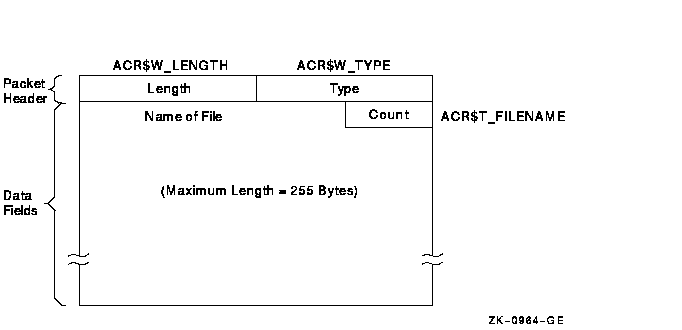
| Symbolic Offset | Description |
|---|---|
| ACR$T_FILENAME | Name of the file (counted ASCII string that gives full file specification). |
The identification packet identifies the process that caused the record to be logged.
Figure C-4 shows the format of the identification packet. Table C-8 describes the fields contained in the packet. See Section C.1.2.1 for information on the packet header.
Figure C-4 Format of an Identification Packet
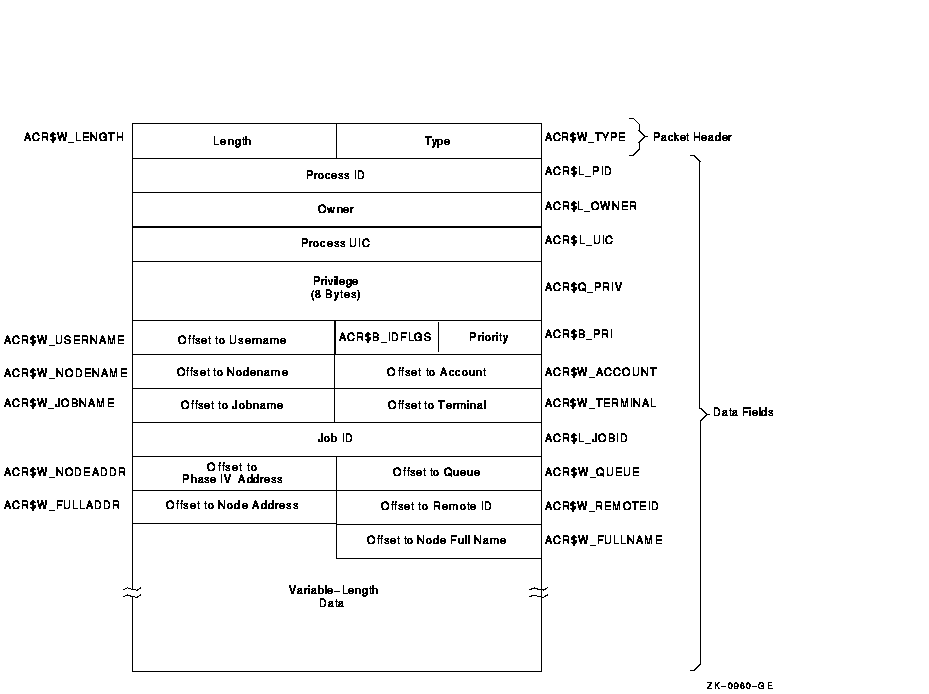
| Symbolic Offset | Description |
|---|---|
| ACR$L_PID | Process identifier (PID) of the process. (longword) |
| ACR$L_OWNER | PID of the parent process. (longword) |
| ACR$L_UIC | UIC of the process. The UIC can be addressed as two separate words: ACR$W_MEM for the member number, and ACR$W_GRP for the group number. (longword) |
| ACR$Q_PRIV | Privileges held by the process. (quadword) |
| ACR$B_PRI | Base priority of the process. (byte) |
| ACR$B_IDFLGS | Flags byte; full address and full name present if low bit is set. |
| ACR$W_USERNAME | Offset to counted ASCII string containing the user name of the process. (word) |
| ACR$W_ACCOUNT | Offset to counted ASCII string containing the account name of the process. (word) |
| ACR$W_NODENAME | Offset to counted ASCII string containing the Phase W node name of the remote process. (word) |
| ACR$W_TERMINAL | Offset to counted ASCII string containing the terminal name. (word) |
| ACR$W_JOBNAME | Offset to counted ASCII string containing the job name. (word) |
| ACR$L_JOBID | Identification of the print or batch job (queue entry number). (longword) |
| ACR$W_QUEUE | Offset to counted ASCII string containing the name of the queue with which a batch or print job is associated. (word) |
| ACR$W_NODEADDR | Offset to a counted binary string containing the Phase W remote node address. (word) |
| ACR$W_REMOTEID | Offset to counted ASCII string containing the remote ID of the remote process (varies with network implementation and use). (word) |
| ACR$W_FULLADDR | Offset to a counted binary string containing the complete remote node network address. On a DECnet-Plus system, this is the remote node's NSAP address. |
| ACR$W_FULLNAME | Offset to a counted ASCII string containing the complete remote node name. On a DECnet-Plus system, this is the remote node's full name. |
The image name packet contains the name of the image executed by the identified process.
Figure C-5 shows the format of the image name packet. Table C-9 describes the field contained in the packet. See Section C.1.2.1 for information on the packet header.
Figure C-5 Format of an Image Name Packet
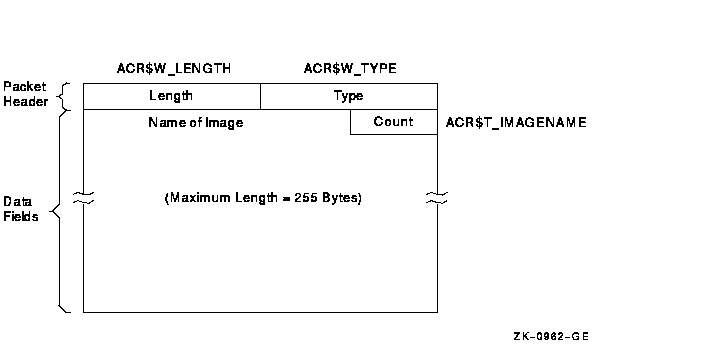
| Symbolic Offset | Description |
|---|---|
| ACR$T_IMAGENAME | Name of the image (counted ASCII string that gives full file specification). |
The print resource packet contains information about print jobs.
Figure C-6 shows the format of the print resource packet. Table C-10 describes the fields contained in the packet. See Section C.1.2.1 for information on the packet header.
Figure C-6 Format of a Print Resource Packet
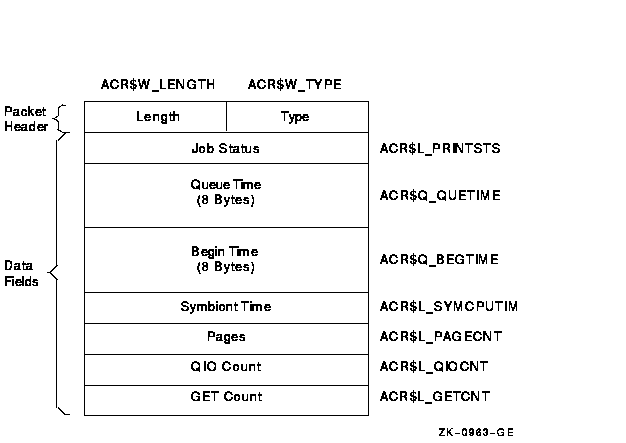
| Symbolic Offset | Description |
|---|---|
| ACR$L_PRINTSTS | Status of the print job. (longword) |
| ACR$Q_QUETIME | Time the job was queued. (64-bit absolute time) |
| ACR$Q_BEGTIME | Time the job was started. (64-bit absolute time) |
| ACR$L_SYMCPUTIM | Symbiont CPU time (always zero). (longword) |
| ACR$L_PAGECNT | Number of pages printed. (longword) |
| ACR$L_QIOCNT | Number of QIOs issued to the printer. (longword) |
| ACR$L_GETCNT | Number of GETs from the file that was printed. (longword) |
The resource packet contains information about the identified process.
Figure C-7 shows the format of a resource packet. Table C-11 describes the fields contained in the packet. See Section C.1.2.1 for information on the packet header.
Figure C-7 Format of a Resource Packet

| Symbolic Offset | Description |
|---|---|
| ACR$Q_LOGIN | 64-bit absolute time at which the image was run or the process was created. (quadword) |
| ACR$L_STATUS | Final exit status of the image, or for a process, the final status of the last image executed in the process. (longword) |
| ACR$L_IMGCNT | Number of images run by the process. (longword) |
| ACR$L_CPUTIME | Total CPU time used by the image or process, measured in units of 10 milliseconds. This includes any vector CPU time. (longword) |
| ACR$L_FAULTS | Number of hard and soft page faults incurred by the image or process. (longword) |
| ACR$L_FAULTIO | Number of hard page faults incurred by the image or process. (longword) |
| ACR$L_WSPEAK | Maximum working set size used by the image or process. (longword) |
| ACR$L_PAGEFL | Maximum page file usage. (longword) |
| ACR$L_DIOCNT | Number of direct I/Os made by the image or process. (longword) |
| ACR$L_BIOCNT | Number of buffered I/Os made by the image or process. (longword) |
| ACR$L_VOLUMES | Number of volumes mounted by the image or process. (longword) |
| ACR$L_VP_CPUTIME | Vector CPU time used by the image or process, measured in units of 10 milliseconds. (longword) |
The user data packet contains an accounting message sent by the $SNDJBC system service.
Figure C-8 shows the format of the user data packet. Table C-12 describes the fields contained in the packet. See Section C.1.2.1 for information on the packet header.
Figure C-8 Format of a User Data Packet
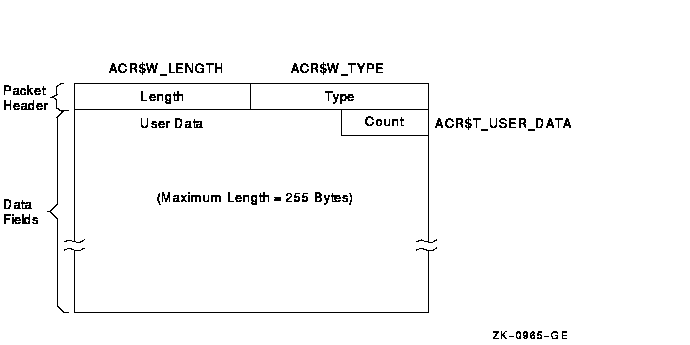
| Symbolic Offset | Description |
|---|---|
| ACR$T_USER_DATA | Up to 255 bytes of data (counted string). |
ANALYZE/DISK_STRUCTURE performs the verification of a volume or volume set in eight distinct stages. During these stages, ANALYZE/DISK_STRUCTURE compiles information that is used in reporting errors and performing repairs.
Before ANALYZE/DISK_STRUCTURE can proceed with each stage, it must perform the following four initialization functions:
The following sections describe the eight stages that
ANALYZE/DISK_STRUCTURE goes through while verifying a disk. These
descriptions assume that you specified the /REPAIR qualifier in the
command. An annotated ANALYZE/DISK_STRUCTURE listing is included at the
end of this appendix.
D.1 Stage 1
In Stage 1, ANALYZE/DISK_STRUCTURE gathers various volume information (such as cluster size, volume labels, and the number of volumes in the set) from several reserved files, verifies the information for accuracy, reports all discrepancies, and corrects problems discovered during this stage.
ANALYZE/DISK_STRUCTURE identifies the volume and all the characteristics of that volume by using the parameters of the home block in INDEXF.SYS. When ANALYZE/DISK_STRUCTURE confirms this information, it builds a current version of VOLSET.SYS in memory and reads and verifies the status control block (SCB) of BITMAP.SYS.
ANALYZE/DISK_STRUCTURE then compares the volume-set attributes for the
version of VOLSET.SYS in memory to the attributes listed in the version
of VOLSET.SYS resident on the volume, reports discrepancies, and
corrects errors.
D.2 Stage 2
In Stage 2, ANALYZE/DISK_STRUCTURE copies the current version of
QUOTA.SYS into working memory, and establishes the structure on which
another QUOTA.SYS file is built during subsequent stages. In Stage 7,
these copies are compared with each other and inconsistencies are
reported.
D.3 Stage 3
Stage 3 checks consist of ANALYZE/DISK_STRUCTURE operations that use the reserved file INDEXF.SYS. During Stage 3, ANALYZE/DISK_STRUCTURE opens INDEXF.SYS, reads each file header, and completes the following steps:
ANALYZE/DISK_STRUCTURE also does the following during Stage 3:
While performing these checks, ANALYZE/DISK_STRUCTURE builds several maps that it uses in subsequent stages. Table D-1 briefly describes each map built in Stage 3.
| Bitmap | Function |
|---|---|
| Valid file numbers | The current state of the bitmap for INDEXF.SYS |
| Lost file numbers | All the valid file numbers not yet found in a directory |
| Directory files | List of all directory files |
| Extension linkages | List of all valid extension headers |
| Multiply allocated clusters | List of all clusters that are referenced by more than one header |
| Allocated clusters | All allocated clusters on the volume (or volume set) |
| System map | The new storage bitmap |
| Valid file backlink | A map of all valid file backlinks |
| Invalid backlink | A map of all invalid backlinks |
In Stage 4, ANALYZE/DISK_STRUCTURE builds a current version of BITMAP.SYS using the maps built during Stage 3. In addition, ANALYZE/DISK_STRUCTURE reports any discrepancies between the headers' maps and the storage bitmap. In Stage 4, ANALYZE/DISK_STRUCTURE does the following:
In this stage, ANALYZE/DISK_STRUCTURE completes a pass of all entries in the invalid backlink map. ANALYZE/DISK_STRUCTURE searches the directory hierarchy of the volume to confirm that all files included in INDEXF.SYS are retrievable through the directory structure. In addition, ANALYZE/DISK_STRUCTURE identifies lost directories and attempts to reestablish valid backlinks to those directories.
In Stage 5, ANALYZE/DISK_STRUCTURE does the following:
Stage 6 is essentially a cleanup operation for lost file headers. Following Stage 5, ANALYZE/DISK_STRUCTURE is left with a list of files that are truly lost---files that have backlinks to nonexistent directories. These files were not traceable through the directory structure. ANALYZE/DISK_STRUCTURE is also left with a list of files with bad backlinks; these files are traceable through the directory structure, but the backlinks of the files do not point back to the directory that contains them.
During Stage 6, ANALYZE/DISK_STRUCTURE does the following:
In this stage, ANALYZE/DISK_STRUCTURE compares the values stored in the quota file built during Stage 2 with those stored in the reserved file QUOTA.SYS. During Stage 7, ANALYZE/DISK_STRUCTURE opens QUOTA.SYS and performs the following operations:
Throughout the first seven stages, ANALYZE/DISK_STRUCTURE places operations that cannot be performed during a particular stage on a deferred list. The list includes FIDs sorted by operation. In Stage 8, ANALYZE/DISK_STRUCTURE performs all operations stored on the deferred list. In Stage 8, ANALYZE/DISK_STRUCTURE does the following:
Example D-1 is an annotated example of an ANALYZE/DISK_STRUCTURE session. The command used to generate this example did not include the /REPAIR qualifier.
Example D-1 ANALYZE/DISK_STRUCTURE---Annotated Example
%VERIFY-I-BADHEADER, file (487,173,1) MAIL$0004008EEAEE0572.MAI;1 (1)
invalid file header
%VERIFY-I-BADHEADER, file (531,112,1) MAIL$0004008EEFBB198B.MAI;1
invalid file header
%VERIFY-I-BADHEADER, file (589,104,1) MAIL$0004008EEAF199B9.MAI;1
invalid file header
%VERIFY-I-BADHEADER, file (604,157,1) MAIL$0004008EF12C3B28.MAI;1
invalid file header
%VERIFY-I-BADHEADER, file (674,247,1) MAIL$0004008EF6053C9B.MAI;1
invalid file header
%VERIFY-I-BADHEADER, file (688,41,1) MAIL$0004008EF608AFF4.MAI;1
invalid file header
%VERIFY-I-BADHEADER, file (689,135,1) MAIL$0004008EEE445A31.MAI;1
invalid file header
%VERIFY-I-BADHEADER, file (750,71,1) MAIL$0004008EEED19ADF.MAI;1
invalid file header
%VERIFY-I-BADHEADER, file (753,217,1) MAIL$0004008EE7C4A017.MAI;1
invalid file header
%VERIFY-I-BADHEADER, file (780,236,1) MAIL$0004008EF777ACA8.MAI;1
invalid file header
%VERIFY-I-BADHEADER, file (852,57,1) MAIL$0004008EF06C15F6.MAI;1
invalid file header
%VERIFY-I-BADHEADER, file (856,44,1) MAIL$0004008EE7D2520D.MAI;1
invalid file header
%VERIFY-I-BADHEADER, file (1059,42,1) MAIL$0004008EEB045608.MAI;1
invalid file header
%VERIFY-I-BADHEADER, file (1134,76,1) MAIL$0004008EE9EC806D.MAI;1
invalid file header
%VERIFY-I-BADHEADER, file (1316,147,1) MAIL$0004008EEEDA734F.MAI;1
invalid file header
%VERIFY-I-BADHEADER, file (1350,74,1) MAIL$0004008EE89BA8B0.MAI;1
invalid file header
%VERIFY-I-BADHEADER, file (1351,64,1) MAIL$0004008EEB09B036.MAI;1
invalid file header
%VERIFY-I-BADHEADER, file (1490,104,1) MAIL$0004008EE8B448B0.MAI;1
invalid file header
%VERIFY-I-BADHEADER, file (1493,106,1) LASTNOTIC.NIL;1
invalid file header
%VERIFY-I-BADHEADER, file (1548,204,1) MAIL$0004008EF7B4D1B8.MAI;1
invalid file header
%VERIFY-I-BADHEADER, file (1613,61,1) MAIL$0004008EECEE4BA5.MAI;1
invalid file header
%VERIFY-I-BADHEADER, file (1812,81,1) MAIL$0004008EE7DF05EC.MAI;1
invalid file header
%VERIFY-I-BADHEADER, file (1848,26,1) MAIL$0004008EF78659B9.MAI;1
invalid file header
%VERIFY-I-BADHEADER, file (1983,34119,1) MAIL$0004008EE7E49C13.MAI;1
invalid file header
%VERIFY-I-BADHEADER, file (1987,33907,1) REMIND.CAL;9
invalid file header
%VERIFY-I-BADHEADER, file (2196,123,1) MAIL$0004008EE6FA2DC9.MAI;1
invalid file header
%VERIFY-I-BADHEADER, file (2372,125,1) MAIL$0004008EF06339F9.MAI;1
invalid file header
%VERIFY-I-BADHEADER, file (2569,67,1) MAIL$0004008EF2BF0C15.MAI;1
invalid file header
%VERIFY-I-BADHEADER, file (2605,72,1) MAIL$0004008EE856FC73.MAI;1
invalid file header
%VERIFY-I-BADHEADER, file (2616,70,1) MAIL$0004008EF063C04F.MAI;1
invalid file header
%VERIFY-I-BADHEADER, file (2774,29818,1) LASTNOTIC.NIL;1
invalid file header
%VERIFY-I-ALLOCCLR, blocks incorrectly marked allocated (2)
LBN 442398 to 445538, RVN 1
%VERIFY-I-BADHEADER, file (487,0,1) MAIL$0004008EEAEE0572.MAI;1 (3)
invalid file header
%VERIFY-I-LOSTEXTHDR, file (487,0,1)
lost extension file header
%VERIFY-I-BADHEADER, file (531,0,1) MAIL$0004008EEFBB198B.MAI;1
invalid file header
%VERIFY-I-LOSTEXTHDR, file (531,0,1)
lost extension file header
%VERIFY-I-BADHEADER, file (589,0,1) MAIL$0004008EEAF199B9.MAI;1
invalid file header
%VERIFY-I-LOSTEXTHDR, file (589,0,1)
lost extension file header
%VERIFY-I-BADHEADER, file (604,0,1) MAIL$0004008EF12C3B28.MAI;1
invalid file header
%VERIFY-I-LOSTEXTHDR, file (604,0,1)
lost extension file header
%VERIFY-I-BADHEADER, file (674,0,1) MAIL$0004008EF6053C9B.MAI;1
invalid file header
%VERIFY-I-LOSTEXTHDR, file (674,0,1)
lost extension file header
%VERIFY-I-BADHEADER, file (688,0,1) MAIL$0004008EF608AFF4.MAI;1
invalid file header
%VERIFY-I-LOSTEXTHDR, file (688,0,1)
lost extension file header
%VERIFY-I-BADHEADER, file (689,0,1) MAIL$0004008EEE445A31.MAI;1
invalid file header
%VERIFY-I-LOSTEXTHDR, file (689,0,1)
lost extension file header
%VERIFY-I-BADHEADER, file (750,0,1) MAIL$0004008EEED19ADF.MAI;1
invalid file header
%VERIFY-I-LOSTEXTHDR, file (750,0,1)
lost extension file header
%VERIFY-I-BADHEADER, file (753,0,1) MAIL$0004008EE7C4A017.MAI;1
invalid file header
%VERIFY-I-LOSTEXTHDR, file (753,0,1)
lost extension file header
%VERIFY-I-BADHEADER, file (780,0,1) MAIL$0004008EF777ACA8.MAI;1
invalid file header
%VERIFY-I-LOSTEXTHDR, file (780,0,1)
lost extension file header
%VERIFY-I-BADHEADER, file (852,0,1) MAIL$0004008EF06C15F6.MAI;1
invalid file header
%VERIFY-I-LOSTEXTHDR, file (852,0,1)
lost extension file header
%VERIFY-I-BADHEADER, file (856,0,1) MAIL$0004008EE7D2520D.MAI;1
invalid file header
%VERIFY-I-LOSTEXTHDR, file (856,0,1)
lost extension file header
%VERIFY-I-BADHEADER, file (1059,0,1) MAIL$0004008EEB045608.MAI;1
invalid file header
%VERIFY-I-LOSTEXTHDR, file (1059,0,1)
lost extension file header
%VERIFY-I-BADHEADER, file (1134,0,1) MAIL$0004008EE9EC806D.MAI;1
invalid file header
%VERIFY-I-LOSTEXTHDR, file (1134,0,1)
lost extension file header
%VERIFY-I-BADHEADER, file (1316,0,1) MAIL$0004008EEEDA734F.MAI;1
invalid file header
%VERIFY-I-LOSTEXTHDR, file (1316,0,1)
lost extension file header
%VERIFY-I-BADHEADER, file (1350,0,1) MAIL$0004008EE89BA8B0.MAI;1
invalid file header
%VERIFY-I-LOSTEXTHDR, file (1350,0,1)
lost extension file header
%VERIFY-I-BADHEADER, file (1351,0,1) MAIL$0004008EEB09B036.MAI;1
invalid file header
%VERIFY-I-LOSTEXTHDR, file (1351,0,1)
lost extension file header
%VERIFY-I-BADHEADER, file (1490,0,1) MAIL$0004008EE8B448B0.MAI;1
invalid file header
%VERIFY-I-LOSTEXTHDR, file (1490,0,1)
lost extension file header
%VERIFY-I-BADHEADER, file (1493,0,1) LASTNOTIC.NIL;1
invalid file header
%VERIFY-I-LOSTEXTHDR, file (1493,0,1)
lost extension file header
%VERIFY-I-BADHEADER, file (1548,0,1) MAIL$0004008EF7B4D1B8.MAI;1
invalid file header
%VERIFY-I-LOSTEXTHDR, file (1548,0,1)
lost extension file header
%VERIFY-I-BADHEADER, file (1613,0,1) MAIL$0004008EECEE4BA5.MAI;1
invalid file header
%VERIFY-I-LOSTEXTHDR, file (1613,0,1)
lost extension file header
%VERIFY-I-BADHEADER, file (1812,0,1) MAIL$0004008EE7DF05EC.MAI;1
invalid file header
%VERIFY-I-LOSTEXTHDR, file (1812,0,1)
lost extension file header
%VERIFY-I-BADHEADER, file (1848,0,1) MAIL$0004008EF78659B9.MAI;1
invalid file header
%VERIFY-I-LOSTEXTHDR, file (1848,0,1)
lost extension file header
%VERIFY-I-BADHEADER, file (1983,0,1) MAIL$0004008EE7E49C13.MAI;1
invalid file header
%VERIFY-I-LOSTEXTHDR, file (1983,0,1)
lost extension file header
%VERIFY-I-BADHEADER, file (1987,0,1) REMIND.CAL;9
invalid file header
%VERIFY-I-LOSTEXTHDR, file (1987,0,1)
lost extension file header
%VERIFY-I-BADHEADER, file (2196,0,1) MAIL$0004008EE6FA2DC9.MAI;1
invalid file header
%VERIFY-I-LOSTEXTHDR, file (2196,0,1)
lost extension file header
%VERIFY-I-BADHEADER, file (2372,0,1) MAIL$0004008EF06339F9.MAI;1
invalid file header
%VERIFY-I-LOSTEXTHDR, file (2372,0,1)
lost extension file header
%VERIFY-I-BADHEADER, file (2569,0,1) MAIL$0004008EF2BF0C15.MAI;1
invalid file header
%VERIFY-I-LOSTEXTHDR, file (2569,0,1)
lost extension file header
%VERIFY-I-BADHEADER, file (2605,0,1) MAIL$0004008EE856FC73.MAI;1
invalid file header
%VERIFY-I-LOSTEXTHDR, file (2605,0,1)
lost extension file header
%VERIFY-I-BADHEADER, file (2616,0,1) MAIL$0004008EF063C04F.MAI;1
invalid file header
%VERIFY-I-LOSTEXTHDR, file (2616,0,1)
lost extension file header
%VERIFY-I-BADHEADER, file (2774,0,1) LASTNOTIC.NIL;1
invalid file header
%VERIFY-I-LOSTEXTHDR, file (2774,0,1)
lost extension file header
%VERIFY-I-BADDIRENT, invalid file identification in directory entry [ALLWAY]NOTES.LOG;25 (4)
%VERIFY-I-BADDIRENT, invalid file identification in directory entry [BLAIN.BOOTS]LOADER.OBJ;1
%VERIFY-I-BADDIRENT, invalid file identification in directory entry [BLAIN.BOOTS]SYSGEN.OBJ;1
%VERIFY-I-BADDIRENT, invalid file identification in directory entry [BLAIN]MAIL_20600841.TMP;1
%VERIFY-I-BADDIRENT, invalid file identification in directory entry [BLAIN]NETSERVER.LOG;181
%VERIFY-I-BADDIRENT, invalid file identification in directory entry [BLAIN]NETSERVER.LOG;180
%VERIFY-I-BADDIRENT, invalid file identification in directory entry [BLAIN]NETSERVER.LOG;179
%VERIFY-I-BADDIRENT, invalid file identification in directory entry [BLAIN]NETSERVER.LOG;178
%VERIFY-I-BADDIRENT, invalid file identification in directory entry [BLAIN]NETSERVER.LOG;170
%VERIFY-I-BADDIRENT, invalid file identification in directory entry [BOEMUS.MAIL]MAIL$0004008EF94A72A0.MAI;1
%VERIFY-I-BADDIRENT, invalid file identification in directory entry [BOEMUS]NETSERVER.LOG;10
%VERIFY-I-BADDIRENT, invalid file identification in directory entry [BOEMUS]UPDATE.LOG;1
%VERIFY-I-BACKLINK, incorrect directory back link [CALGON.GER]OBJ.DIR;1
%VERIFY-I-BADDIRENT, invalid file identification in directory entry [CALGON]T.TMP;1
%VERIFY-I-BACKLINK, incorrect directory back link [CLABIN.BACKUP.TMPSRC]BACKDEF.SDL;1
%VERIFY-I-BACKLINK, incorrect directory back link [CLABIN.BACKUP.TMPSRC]COMMON.REQ;1
%VERIFY-I-BACKLINK, incorrect directory back link [CLABIN.BACKUP.TMPSRC]DUMMY.MSG;1
%VERIFY-I-BADDIRENT, invalid file identification in directory entry [CLABIN.NMAIL]NMAIL.LOG;77
%VERIFY-I-BADDIRENT, invalid file identification in directory entry [CLABIN.NMAIL]NMAIL.LOG;76
%VERIFY-I-BADDIRENT, invalid file identification in directory entry [DESIN.8800]2840HT86.GNC;1
%VERIFY-I-BADDIRENT, invalid file identification in directory entry [DESIN.8800]2840TP86.GNC;1
%VERIFY-I-BADDIRENT, invalid file identification in directory entry [DOWNE.MAIL]MAIL$0004008EF94A79B3.MAI;1
%VERIFY-I-BADDIRENT, invalid file identification in directory entry [DOWNE.PRO]MORT.OBJ;15
%VERIFY-I-BADDIRENT, invalid file identification in directory entry [DOWNE.PRO]OUTPUT.LOG;36
%VERIFY-I-BADDIRENT, invalid file identification in directory entry [DOWNE.PRO]OUTPUT.LOG;35
%VERIFY-I-BADDIRENT, invalid file identification in directory entry [DOWNE.PRO]OUTPUT.LOG;34
%VERIFY-I-BADDIRENT, invalid file identification in directory entry [DOWNE.PRO]OUTPUT.LOG;33
%VERIFY-I-BADDIRENT, invalid file identification in directory entry [DOWNE.PRO]OUTPUT.LOG;32
%VERIFY-I-BADDIRENT, invalid file identification in directory entry [DOWNE.PRO]OUTPUT.LOG;31
%VERIFY-I-BADDIRENT, invalid file identification in directory entry [DOWNE.PRO]OUTPUT.LOG;30
%VERIFY-I-BADDIRENT, invalid file identification in directory entry [GAMBLE]CONFLICTS.LIS;1
%VERIFY-I-BADDIRENT, invalid file identification in directory entry [GAMBLE.DOC]SMP.LOCK;6
%VERIFY-I-BADDIRENT, invalid file identification in directory entry [GAMBLE]NETSERVER.LOG;5
%VERIFY-I-BADDIRENT, invalid file identification in directory entry [GAMBLE.NMAIL]NMAIL.LOG;22
%VERIFY-I-BADDIRENT, invalid file identification in directory entry [GAMBLE.NMAIL]NMAIL.LOG;21
%VERIFY-I-BADDIRENT, invalid file identification in directory entry [GILLEY.MAIL]MAIL$0004008EF94A7B70.MAI;1
%VERIFY-I-BADDIRENT, invalid file identification in directory entry [GILLEY]NETSERVER.LOG;657
%VERIFY-I-BADDIRENT, invalid file identification in
directory entry [GILLEY]NETSERVER.LOG;656
%VERIFY-I-BADDIRENT, invalid file identification in directory entry [HALL]2.LOG;33
%VERIFY-I-BADDIRENT, invalid file identification in directory entry [HALL]2.LOG;32
%VERIFY-I-BADDIRENT, invalid file identification in directory entry [HALL]2.LOG;31
%VERIFY-I-BADDIRENT, invalid file identification in directory entry [HALL]2.LOG;30
%VERIFY-I-BADDIRENT, invalid file identification in directory entry [HALL]2.LOG;29
%VERIFY-I-BADDIRENT, invalid file identification in directory entry [HALL]2.LOG;28
%VERIFY-I-BADDIRENT, invalid file identification in directory entry [HALL]2.LOG;27
%VERIFY-I-BADDIRENT, invalid file identification in directory entry [HALL]2.LOG;26
%VERIFY-I-BADDIRENT, invalid file identification in directory entry [HALL]2.LOG;25
%VERIFY-I-BADDIRENT, invalid file identification in directory entry [HALL]2.LOG;24
%VERIFY-I-BADDIRENT, invalid file identification in directory entry [NAMOLLY]NETSERVER.LOG;2
%VERIFY-I-BADDIRENT, invalid file identification in directory entry [NAMOLLY]NETSERVER.LOG;1
%VERIFY-I-BADDIRENT, invalid file identification in directory entry [RUSS]082654.LOG;1
%VERIFY-I-BADDIRENT, invalid file identification in directory entry [SCHROEDER.LOGIN]NETSERVER.LOG;17
%VERIFY-I-BADDIR, directory [SYSLOST.BOOTS] has invalid format
%VERIFY-I-BADDIRENT, invalid file identification in directory entry [THOEN]NETSERVER.LOG;374
%VERIFY-I-BADDIRENT, invalid file identification in directory entry [THOEN]NETSERVER.LOG;373
%VERIFY-I-BADDIRENT, invalid file identification in directory entry [THOEN]NETSERVER.LOG;367
%VERIFY-I-BADDIRENT, invalid file identification in directory entry [THOMAS.MAIL]MAIL$0004008EF94D75EB.MAI;1
%VERIFY-I-BADDIRENT, invalid file identification in directory entry [THOMAS.MAIL]MAIL$0004008EF955DDF3.MAI;1
%VERIFY-I-BADDIRENT, invalid file identification in directory entry [THOMAS.MAIL]MAIL$0004008EFD118B44.MAI;1
%VERIFY-I-LOSTSCAN, due to directory errors, lost files will not be entered (5)
%VERIFY-I-INCQUOTA, QUOTA.SYS indicates 69663 blocks used, actual use is 69740 blocks for [11,402] (6)
%VERIFY-I-INCQUOTA, QUOTA.SYS indicates 1764 blocks used, actual use is 1770 blocks for [12,12]
%VERIFY-I-INCQUOTA, QUOTA.SYS indicates 0 blocks used, actual use is 31 blocks for [11,720]
![[HR]](../../IMAGES/REDBAR.GIF)
6048P060.HTM OSSG Documentation 26-NOV-1996 12:43:51.93
Copyright © Digital Equipment Corporation 1996. All Rights Reserved.